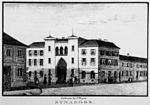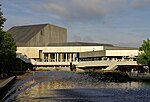Karlsruhe Institute of Technology

The Karlsruhe Institute of Technology (KIT; German: Karlsruher Institut für Technologie) is a public research university in Karlsruhe, Germany. The institute is a national research center of the Helmholtz Association.KIT was created in 2009 when the University of Karlsruhe (Universität Karlsruhe), founded in 1825 as a public research university and also known as the "Fridericiana", merged with the Karlsruhe Research Center (Forschungszentrum Karlsruhe), which had originally been established in 1956 as a national nuclear research center (Kernforschungszentrum Karlsruhe, or KfK).KIT is a member of the TU9, an incorporated society of the largest and most notable German institutes of technology. As part of the German Universities Excellence Initiative KIT was one of three universities which were awarded excellence status in 2006. In the following "German Excellence Strategy" KIT was awarded as one of eleven "Excellence Universities" in 2019. KIT is among the leading technical universities in Germany and Europe. According to different bibliometric rankings, KIT is the German university with the strongest research in engineering and natural sciences.In the university part of today's KIT, science-based mechanical engineering was founded in the mid-19th century under the direction of Ferdinand Redtenbacher, which influenced the foundation of other technical universities, such as ETH Zurich in 1855. The university is also among the pioneers of computer science research in Germany. It established the first German faculty for computer science in 1972. On 2 August 1984, the University received the first-ever German e-mail. In the 1990s, all .de domains were registered and managed at the University of Karlsruhe. The same was true for Chinese .cn domains.KIT alumni and faculty include six Nobel Prize laureates and nine Leibniz Prize winners. The Karlsruhe Institute of Technology is well known for many inventors and entrepreneurs who studied or taught there, including Heinrich Hertz, Karl Friedrich Benz and the founders of SAP SE.
Excerpt from the Wikipedia article Karlsruhe Institute of Technology (License: CC BY-SA 3.0, Authors, Images).Karlsruhe Institute of Technology
Kaiserstraße, Karlsruhe Innenstadt-Ost
Geographical coordinates (GPS) Address Nearby Places Show on map
Geographical coordinates (GPS)
| Latitude | Longitude |
|---|---|
| N 49.009444444444 ° | E 8.4116666666667 ° |
Address
Hauptgebäude (Rektorat / Verwaltung)
Kaiserstraße 12
76131 Karlsruhe, Innenstadt-Ost
Baden-Württemberg, Germany
Open on Google Maps










